digital holiday
somaya langley: unguided tours, anne landa award exhibition, 2011
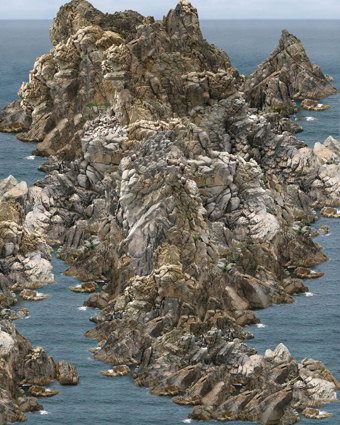
Jae Hoon Lee, Ha Jo Doe, 2010, digitally collaged photography
courtesy of the artist and Starkwhite, Auckland
Jae Hoon Lee, Ha Jo Doe, 2010, digitally collaged photography
PUTTING ON MY GLASSES, THE LARGE-SCALE DIGITAL PHOTOGRAPHY OF JAE HOON LEE COMES INTO FOCUS AND I NEED TO STRIDE BACKWARDS IN ORDER TO TAKE IT ALL IN. REMINISCENT OF A GATEWAY TO AN ANCIENT TEMPLE, THE OVERSIZED IMAGES TITLED HA JO DAE 2 AND TREKKING 2 MARK THE ENTRANCE TO UNGUIDED TOURS: THE 2011 ANNE LANDA AWARD FOR VIDEO AND NEW MEDIA ARTS EXHIBITION AT THE ART GALLERY OF NEW SOUTH WALES.
jae hoon lee, ha joe dae 2, trekking 2 and levitation
To the left appears a landscape of ocean and rocky outcrops. Looking as if they have been constructed chunk-by-chunk, these formations rise from the sea; patterns of indistinguishable similarity emerge, then deviate. To the right, Trekking 2 features a path repeatedly zigzagging, cutting into the sheer, barren mountainside. Someone passing by comments: “God, you wouldn’t want to run off that road.” Spectators stop, pondering where in the world this incredible hillside track might be; until they twig. Or perhaps some of them don’t. Uncannily similar furrows of snow appearing in the crevices are in fact identical. By means of a digital cut-n-paste remix, Trekking 2 takes what is already an awe-inspiring landscape one step further.
Fittingly, Jae Hoon Lee’s Levitation sits between these two digital image giants. The constant ding of a small, tinny yet reverberant bell heralds the exhibition’s entry point. The resonant Buddhist’s bell sound accompanies beautiful textures (in deep ambers, rich chocolates and jade greens) of moss-adorned bricks on screen, slowly rising upwards. Having passed over the threshold, I begin my journey through New Zealander Justin Paton’s curation of award contenders, titled Unguided tours.
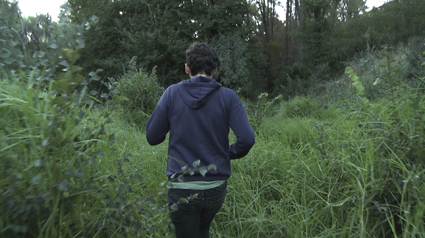
Charlie Sofo, 2010-11, mixed materials digital videos
courtesy of the artist and the Art Gallery of NSW
Charlie Sofo, 2010-11, mixed materials digital videos
charlie sofo, fields 2010-2011
In contrast to Lee’s meditative landscapes, Charlie Sofo’s Fields 2010-2011 is a solid reality check; familiar to all who have ever ventured into the Australian suburbs. Over the past year or so, Sofo has enlivened his potentially boring everyday journeys by gathering like objects. An array of videos, slideshows, as well as the items themselves are clinically displayed: small pebbles collected by way of getting stuck in the grooves of the artist’s shoes, chips of coloured paint, a Google map indicating where condoms and/or condom wrappers have been discarded around Melbourne’s suburbs of Brunswick and Northcote and a box of pastel-coloured cards, each announcing yet another venue (presumably somewhere the artist frequented) has closed down. The premise of Fields 2010-2011 is to attempt to assist the audience in “looking anew at what’s already there.” For one audience member, a small component of Sofo’s work becomes incredibly significant: a video of various neighbourhood cats contains a fleeting image of what she thinks might have been her own cat, who recently passed away. In asking his audience to view tiny scraps of the everyday in a new light, Sofo offers us a way to invest meaning in our banal daily treks.
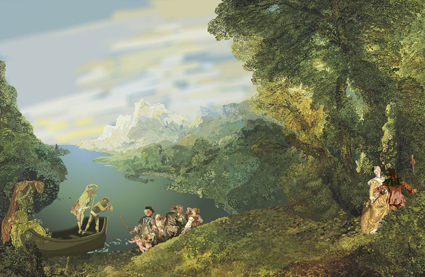
Arlo Mountford, The lament, 2010-2011, two channel digital animation with 5.1 surround sound
courtesy of the artist and the Art Gallery of NSW
Arlo Mountford, The lament, 2010-2011, two channel digital animation with 5.1 surround sound
arlo mountford, the lament
Stepping away from the doldrums of familiar life, we are back in the surreal once again. Arlo Mountford’s The Lament is another large-scale digital work—a painting virtually brought to life. This is a fairytale remix of sorts. Taking the two versions of Watteau’s L’embarquement pour Cythere (Embarkation for Cythera) stitched together, the creator then bestows upon this work the breath of life. Taking the time to sit and observe as a peaceful scene unfolds, what becomes noticeable is actually the large degree of activity taking place. Lovers kiss, birds twitter away, a dog rushes around (the spatialised audio space) barking excitedly, waves lap at the shores, couples—flanked by chubby flying cupids—either embark or disembark from the wooden boat, which then encircles the island, partially cloaked by drifting digital mists. For me, this work provides brief solace before returning to hectic city life.
rachel khedoori, untitled
From one natural setting to another, Rachel Khedoori’s Untitled presents a panorama unfolding from the middle, an old technique used in moving imagery, yet Khedoori’s work does not concentrate on this trick. Instead, the symmetry and smoothness of movement help to draw focus towards the endlessness of a lush bush-scape, peeling outwards forever. A group of kids gather to watch, emitting a collective “whoa…”
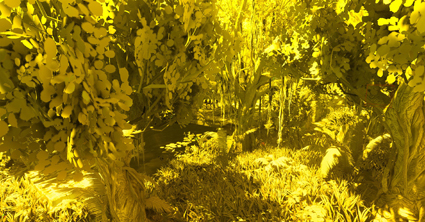
David Haines and Joyce Hinterding, The Outlands 2011, projected real time 3D environment utilising the Unreal Engine; additional sound Rosy Parlane, Michael Morley and Danny Butt
courtesy of the artist and the Art Gallery of NSW
David Haines and Joyce Hinterding, The Outlands 2011, projected real time 3D environment utilising the Unreal Engine; additional sound Rosy Parlane, Michael Morley and Danny Butt
david haines and joyce hinterding, the outlands
I follow the kids and their parents into The outlands, David Haines and Joyce Hinterding’s game environment, knowing it’s going to be a while before I get my turn. As I enter the space, The outlands creaks with sounds from the shadowy vegetation, created by New Zealanders Rosy Parlane, Michael Morley and Danny Butt. With only two controller “sticks” (joysticks with large dead twigs attached), diplomatically sharing these between a large group of kids calls for other forms of interaction. Without hesitation, some of them crouch down in front of the floor to ceiling projection, pretending to be prowling animals and then slowly swaying from side to side as if aboard a vessel traversing this imaginary landscape. Hovering above a blue-tinged black swamp, surrounded by low-lying branches and deadwood, we fly towards the towering rock formations. The kids were happy to improvise their own interactivity but I wanted to demand much more from the winner of the $25,000 acquisitive Anne Landa Award for 2011. What I desired was a greater degree of immersion (in both this work and also in the overall scope of the exhibition), with fewer works presented as if they were paintings or photographs, merely shifted into the video realm.
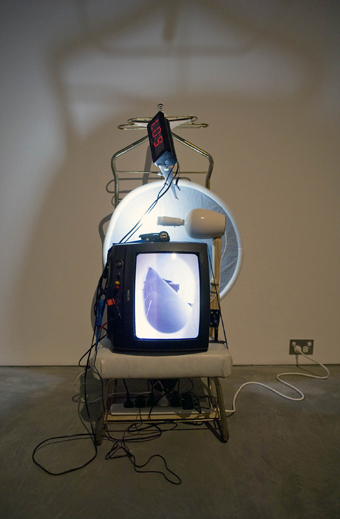
Ian Burns, 15 hours v4, 2010, found object, kinetic sculpture, live video and audio
courtesy of the artist and the Art Gallery of NSW
Ian Burns, 15 hours v4, 2010, found object, kinetic sculpture, live video and audio
ian burns, various
While at first glance it didn’t look like much—just a random bunch of old junk cable-tied and taped together—the pièce de résistance of Unguided tours was the work of Ian Burns though I’ll admit it did take me some time to comprehend what was actually going on. Commencing with Well Read, homage to the road trip and car culture, your eye wanders these sculptures of second-hand odds and ends, eventually settling on two analogue TV screens strapped to the front. Switching between different camera angles, a car drives along open roads, blue sky above. The driver, a peroxide blonde Ken doll, bobs along as the wheels of the car spin…on what turns out to be a seven-inch of Time Bandits’ “Endless Road.” These unremarkable objects are cleverly pieced together to create an illusion found regularly on our screens.
With each of his works in the exhibition (including From orbit displayed in the gallery’s entrance), Burns takes the lid off various movie-like scenes of travel we believe in and commit to so wholeheartedly, exposing the underbelly of smoke and mirrors. Standing in the passageway between Makin’ tracks and 15 hours v4 (an endless view from an aeroplane window over the plane’s wing), I overhear a 20-something comment as he passes by that “it’s just shit really, I don’t get it.” The combination of this remark and Burns’ works illuminates the real crux of Unguided tours. While there may be a general preconception that the digital realm is all about instant gratification, these works require a time commitment. Their messages are not immediate.
From familiar digital suburban-scapes through to pristine pixel wilderness, while none of these works demands attention, you are only granted insight if you take the time to contemplate. This is the same headspace one enters when travelling solo through unfamiliar countries and cultures: precisely what each of these artists must have done at some point, in order to produce these offerings. But while the “touring” aspect of the exhibition works, I am less convinced by the “unguided” framing since, regardless of whether or not a conventional narrative is present, many of the works still portray a semi-predictable journey, one that is predetermined by the digital tools they employ. Nevertheless, this concern is of far less importance than the feeling that I depart with—I have been reinvigorated, as if returning from a holiday, and I haven’t even left town.
Unguided tours: Anne Landa Award for Video and New Media Arts, 2011, Art Gallery of NSW, May 5-July 10; www.artgallery.nsw.gov.au
This article first appeared in our July 26 e-dition.
RealTime issue #104 Aug-Sept 2011 pg. web






